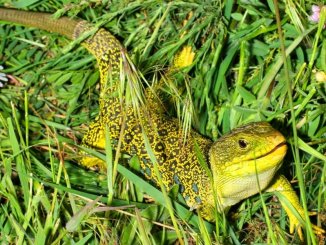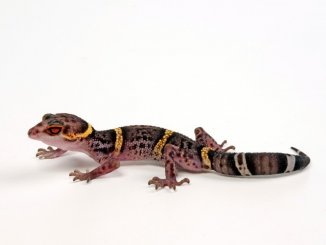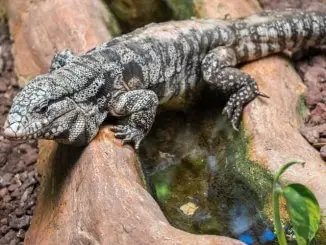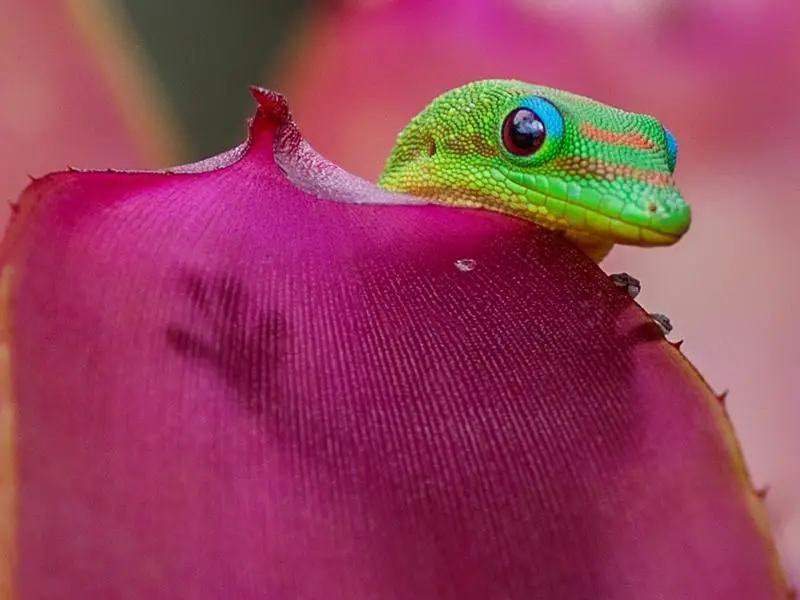
The gold dust day gecko is a small colorful lizard native to Northern Madagascar. Despite its name, the gecko is not golden or yellow, but bright green.
A gold dust day gecko makes an excellent pet for an intermediate-level or experienced owner because this reptile has a range of requirements to make sure it thrives in captivity, such as temperature, lighting, humidity, and tank setup. This small lizard is active, fun to watch, and will make a colorful addition to any home.
Gold Dust Day Gecko Overview
| Common name | Gold dust day gecko |
| Scientific name | Phelsuma laticauda |
| Natural habitat | Forests, gardens |
| Adult size | 4–6 inches long |
| Average lifespan | 10 years |
| Diet | Omnivore |
| Housing | Aquarium or terrarium |
| Experience | Intermediate/Advanced |
Origin
The gold dust day gecko (Phelsuma laticauda) is a species native to Northern Madagascar and the island of Comoros in southern Africa. Gold dust day geckos have also been introduced to Hawaii and other islands in the Pacific.
Gold dust day geckos are arboreal reptiles that are found in areas populated by trees and plants, such as forests and shrublands, as well as urban areas with lots of parks and gardens. These geckos can also be found living on trees or in residential houses in regions where they are endemic.
Appearance and Behavior
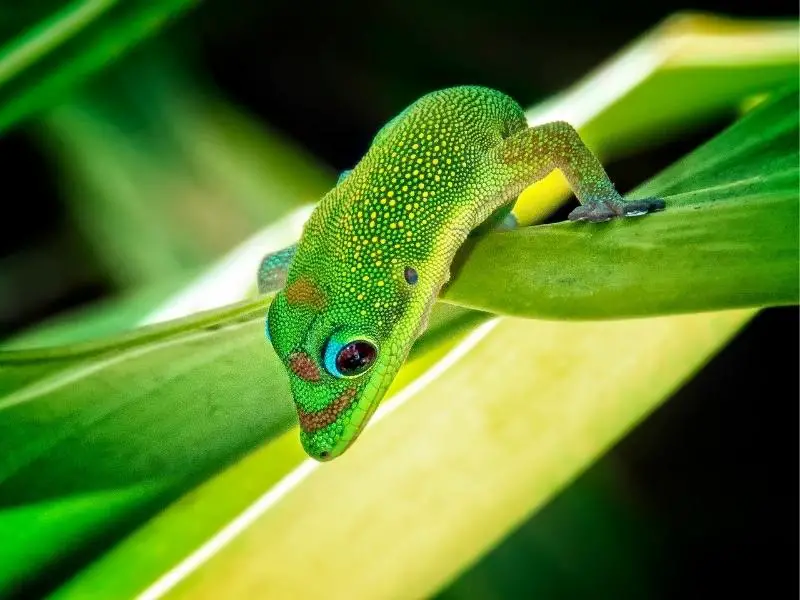
Gold dust day geckos are recognized by their vivid tropical colors, most commonly bright green or yellowish green and, in rare cases, bright blue. The reptiles also have bright blue crescent-like shapes above the top of their black eyes. The small lizards also do not have eyelids. Gold dust day geckos often have small red dots on their upper backs or necks.
Male and female gold dust day geckos look almost identical. But male geckos have pre-anal pores between their legs, which are V-shaped lines of black or brown dots in between their legs, while females don’t have them at all.
Gold dust day geckos are diurnal creatures, which means they are active during the day.
Size and Lifespan
The gold dust day gecko is relatively small, reaching up to six inches in length (including the tail) in adulthood. When just hatched, gold dust day geckos are just two inches long, and they continue to grow to their adult size for about a year.
In captivity, a gold dust day gecko can live up to 15 years, given the conditions they are kept in are proper and the reptile does not experience long-standing health issues.
Temperament
Gold dust day geckos are social creatures and often form groups in the wild when living in the same tree. But gold dust day gecko males are rather aggressive and territorial, finding it hard to co-exist. This is why it’s not recommended to house two male gold dust day geckos in one aquarium because they can get into fights and even kill each other. Females can also get territorial, so it’s best to house these lizards together in a large enough enclosure where each can find its own place.
The gold dust day lizard is an easily stressed reptile, especially when handled. When feeling threatened, these animals can bite quite painfully.
Housing Gold Dust Day Gecko
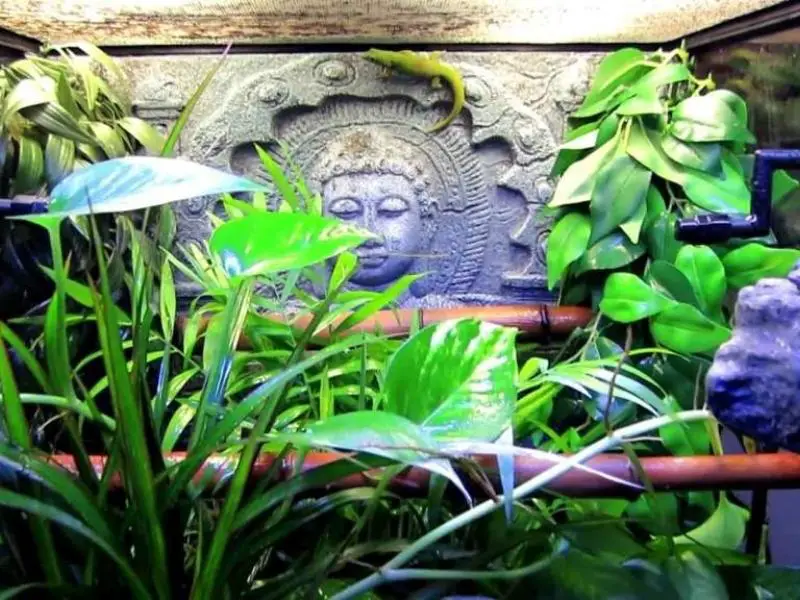
The gold dust day gecko is native to the region of Northern Madagascar and islands in the Indian ocean. The geckos live in the trees and shrubs located in the forests and shrublands. These lizards are used to hot climates and high humidity.
In captivity, gold dust day geckos enjoy warm temperatures and an abundance of plants that mimic their natural habitat conditions. The best type of enclosure for an adult golden dust day gecko is a glass aquarium or a terrarium.
Enclosure size
A gold dust day gecko is a relatively small reptile which means it does not need a large enclosure that takes up a lot of space at home. Young gold dust day geckos can be kept in a square tank as small as 12 inches high and 12 inches wide. A pair of adults, a male, and a female, will thrive in a tank that is 18 inches high, 18 inches wide, and 24 inches high.
It’s best to use a vertically oriented enclosure because this species enjoys climbing and needs a gradient of temperatures with the warmest at the top. These conditions are the closest to their natural habitat in the forest.
Lighting
These small bright reptiles need a lot of bright light in their tank to stay healthy and happy. Gold dust day geckos need a UVB light in the terrarium. If the enclosure is small, the best option would be a UVB bulb. If the gold dust day gecko tank is a bigger one, consider introducing a UVB tube inside the terrarium.
A gold dust day gecko needs 12 hours of exposure to UVB light a day. If the reptile does not get enough light, it starts losing its bright colors and becomes dull.
Temperature and Humidity
The gold dust day gecko is native to regions with hot climates, which should be reflected in the conditions of its enclosure. The gold dust day gecko is a cold-blooded creature and it cannot regulate its body temperature automatically, so it needs an appropriate temperature gradient in the tank, with both colder and warmer areas. In the basking area of the tank, the temperature should be set at around 90°, while the cooler area needs to be between 72°F and 77°F.
The humidity level in the tank should stay at the level of 80%, which can be done by misting the tank twice a day. Alternatively, place a humidifier in the tank to keep the level of humidity consistent throughout the day. Humidity in the tank is also better maintained with the right type of substrate in the tank.
Substrate and Decoration
Gold dust day geckos require a high-quality substrate that holds moisture. Some of the best types of substrate for a gold dust day gecko tank are peat moss, cypress mulch, or orchid bark. As an option, add sphagnum moss as a top layer of the substrate to better retain humidity in the enclosure.
The gold dust day gecko is a reptile native to plant-rich areas and enjoys a lot of vegetation in its tank. Introduce several live or artificial plants in the tank, including vines, to encourage the reptile to climb and to provide a lot of hiding space. Live plants also contribute to stable humidity levels in the tank but require good-quality potting soil and additional care to thrive. Live plants in the tank can be combined with artificial ones. The best live plants to consider adding to the gold dust day gecko tank are dracaena, pothos, philodendron, or bromelia.
Add some branches, smooth rocks, and bamboo stalks to help the gecko feel more at home.
Cleaning
The gold dust day gecko’s enclosure should be cleaned once a month, using a 10% bleach solution to wipe the surfaces of the tank. It’s best to use a non-scented cleaning solution and avoid spraying the tank, especially if the pet cannot be removed safely. If the gecko is socialized, remove the lizard from the tank gently and place it in a separate container with high enough walls so that it doesn’t escape.
While cleaning, remove the decorations and plants and soak the pieces in the cleaning solution for 30 minutes for disinfection, or simply put items like water bowls and plastic decorations in a dishwasher. Scoop out the dirty parts of the substrate and replace them with the fresh mixture.
Gold Dust Day Gecko Care
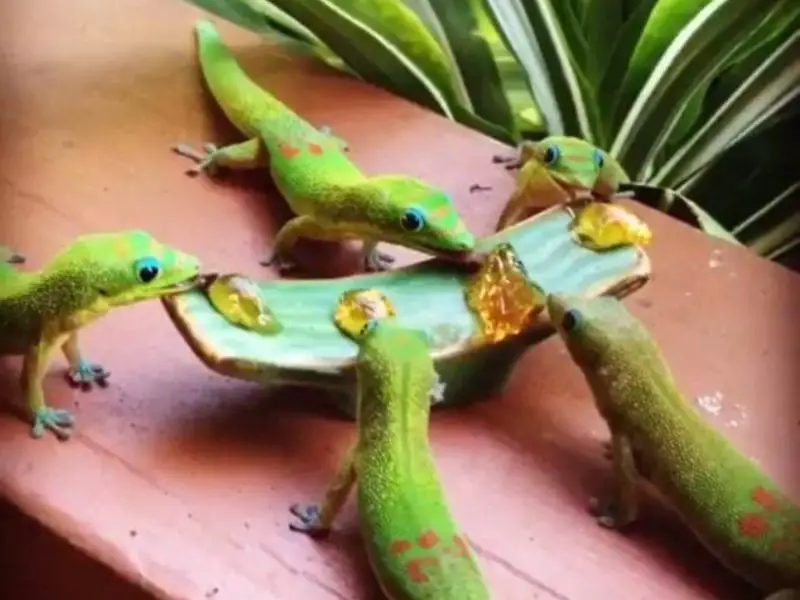
A gold dust day gecko is a reptile that needs an owner with intermediate experience in handling reptiles at home. As pets, gold dust day geckos need special conditions in the tank, as well as a balanced diet to thrive.
Food and Water
Gold dust day geckos are quite easy to feed at home because most of the foods they eat are readily available in pet stores and online. In their natural habitat, gold dust day geckos consume insects, flowers, and nectar, so their feeding schedule in the enclosure should include plant-based and protein foods.
Give the gold dust day gecko a variety of insects to ensure nutritional balance, including crickets, mealworms, roaches, and fruit flies. The insects should be small enough for the gecko to eat. The best rule is to make sure that the insect is not bigger than the width of the gecko’s head. Dust the insects with supplemental vitamin and calcium powder for geckos as a way to fortify the lizard’s diet.
Feed the gecko with insects twice a week, and give the reptile some mashed fruit once a week. Juvenile gold dust day geckos can be fed once every two days until the age of six months.
Gold dust day geckos need a bowl of clean drinking water to be placed in the terrarium. Make sure to change the water once every few days to maintain the appropriate level of hygiene in the tank.
Handling
Gold dust day geckos should be handled with great care because these reptiles don’t enjoy being touched. The skin of these small reptiles is very fragile and can rip from a touch that’s not gentle enough.
It’s best to limit touching to giving the geckos some insects to eat from the tip of the finger. The gecko should not be touched for the first two weeks after it has been introduced to the tank, allowing the reptile time to settle in the new home.
Common Health Issues
While gold dust day geckos are generally healthy lizards, it’s best to find a vet specializing in exotic animals before any health issues arise. These geckos can suffer from a number of common diseases most reptiles suffer from.
Gold dust day geckos, like many reptiles, are prone to parasites. Parasitic infections can be prevented by taking the lizard to a vet for a fecal test once a year. Parasites can cause symptoms like vomiting, lethargy, and weight loss, which means the problem has reached a dangerous level for the gecko.
The lizards can also suffer from the metabolic bone disease common among many reptiles. The disease is caused by the lack of vitamins and calcium, resulting in the greater fragility of the lizard’s bones. Metabolic bone disease can be prevented by providing the pet with enough UVB light and enough calcium supplements in its diet.
Gold dust day geckos can suffer from respiratory infections if the conditions in the enclosure are not up to standard, linked either to low temperatures or high humidity. If the gecko is lethargic and breathes with an open mouth, it might be a sign that the pet is experiencing a respiratory issue. If the symptoms are present, it’s best to take the gold dust day gecko to the vet who might prescribe antibiotics to treat the problem.
Finally, gold dust day geckos are prone to skin issues, such as irregular shedding. Skin conditions can be caused by low humidity levels in the enclosure.
Breeding
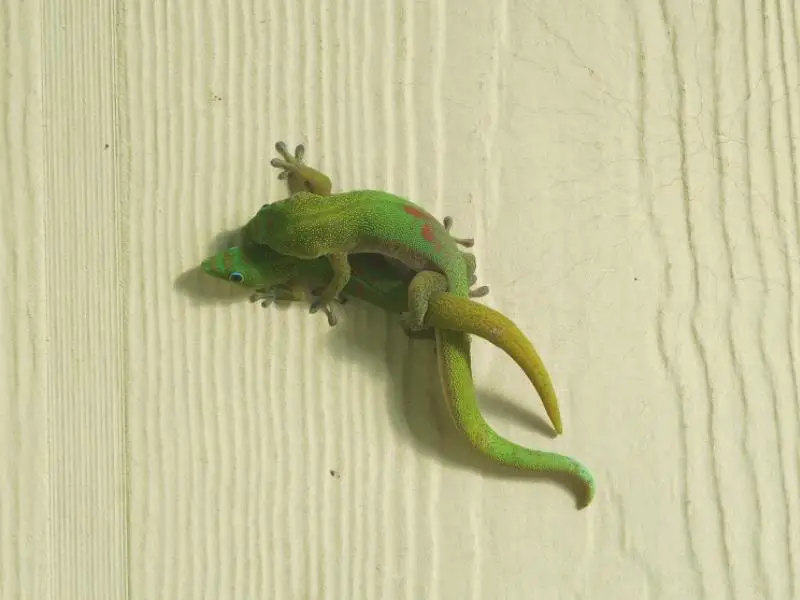
To breed gold dust day geckos at home it’s enough to house a male and a female in the same enclosure. Gold dust day geckos are ready to breed from the age of one year. During the breeding season, the female is likely to lay eggs once every two weeks, if the animal is healthy and the conditions in the tank are correct.
Once the eggs are laid, they should be removed from the enclosure and incubated separately, because the parents may eat the babies when they are hatched. The eggs should be incubated in a small container with a lid at a temperature between 80°F and 82°F and a humidity level of 60%. The eggs will hatch around 45 days after the start of the incubation period.
Choosing and Buying a Gold Dust Day Gecko
A gold dust day gecko can cost anywhere between $60 and $250, depending on its age, origin, and the reputation of the breeder. Gold dust day geckos can be found in pet stores in the US relatively easily.
It’s best to consider a breeder with a good reputation to avoid ongoing health issues. Make sure to arrange to see the reptile in person before taking it home and pay attention to its skin conditions, eyes, and coloration. A healthy gecko has bright skin and clear eyes.

